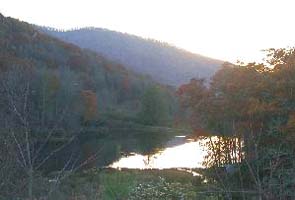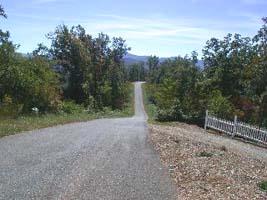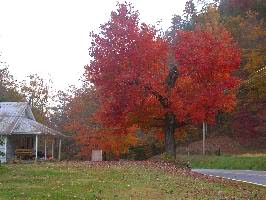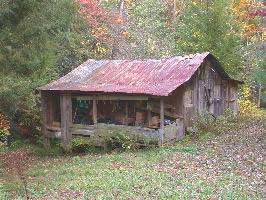a Home in the Mountains
You just love the mountains and want to live in your
very own home here, but you have many questions.
 This article
This article
will help you
find answers
to many
questions
like:
How can I:
· make sure my home is built properly?
· make sure I can afford the house I want?
· choose a good builder?
· make sure the builder understands what I want?
· be sure my home meets all the legal requirements?
· choose a good building lot?
Bookmark this article and follow these ten
easy steps to avoid many costly mistakes:
How to Contact The Mountain Home Show
Appreciation......
This web site contains information obtained from various sources.
The Mountain Home Show is not liable for the accuracy of this information.
Please contact the source of this information with your questions.
 1. Decide
1. Decide
what kind
of home
you want.
Before choosing a property, imagine living in the mountains.
What kind of home do you want to live in?
Make a file of pictures you like from magazines and books,
your favorite kitchen, the special trim you want,
that beautiful bathroom you love,
anything else that impresses you.
An idea file will help everyone
understand what you want.
 2. Set
2. Set
your
budget.
It is a good idea to set your budget first, even before you buy property.
You don't want to spend so much on land that you cannot build.
How much do you have saved? How much can you borrow?
A mortgage officer can "prequalify" you by looking at your
income and expenses. They can tell you how much you can
afford for a house payment and how much you can borrow.
Don't plan your budget too tight. Unexpected changes
like an increase in mortgage interest rates could make
your payments larger than you planned. How much
of your budget can be spent on building and how much
on property? A realtor can help you compare the prices
of land and recently built homes.
Knowing how much was spent on property, site work,
and construction can help you set your budget.
 3. Find
3. Find
your
land.
A realtor can help you find affordable land. The multiple listings service
is a great way to compare many properties in your budget. This is a
computer list of all of the properties for sale in your area that are listed
by a realtor. Your agent can help you search for properties in your budget.
But price is not the only factor to consider. Do you like the privacy of
lots of trees, or the openness of a clear view?
How will the property be in the winter? (Snow melts more quickly
off a south facing slope). Will the road be too treacherous? Will the site
have too much wind? Is the location convenient? Is the property too far
from town or work? What is the neighborhood like? Can you get all
the utilities you want? How will your style of home look on this lot?
Remember, you may not find the perfect property, but
if you are more specific, your realtor can be more helpful in your search.
When you have decided on a property, make an offer with contingencies that
1) you get acceptable financing, water, septic, and driving access,
2) the property passes a title search and survey, and
3) you can get permits to build your home on this lot.
The purchase price is usually negotiable.
It is expected that you make a deposit of money with your offer.
This guarantees the seller that you will not back
out as long as your terms and contingencies are met.
This deposit also shows the seller that your offer is serious.
Wait until you reach step (8) to close on the property.
 4. Choose
4. Choose
your
designer
to plan
your home.
A professional home designer can help protect you
from many of the challenges of building a mountain home:
Foundation movement
Wet basements
Septic problems
Flood plane regulations
Driving access
High winds
Freezing weather
Damp climate
Higher costs
How can you be sure your home will be built properly?
A good set of plans (as part of your builder's contract) can be a protection.
These plans can help your builder understand what you want.
They can make his job easier. Banks prefer good plans as well.
Its a good idea to put everything in writing.
A local designer (who is familiar with this area) can foresee many costly problems.
You will not have this protection if you order your plans
from a magazine or online. Those ordered plans might cost a few thousand less
but could increase construction costs much more.
Before starting the plans a professional designer would visit your property to answer:
How will your home fit on your property? How can you save trees and still have a view?
Will facing the glass towards the view let in too much summer sun, or winter cold?
Planning for the direction of the sun is the best way to reduce energy costs
and make your home more comfortable.
How can the driveway be brought in? Where will the septic go?
A good set of plans is an investment that can pay off in lower construction costs,
energy costs, and a much better home.
After listening to your ideas and visiting your property, your designer will
create a preliminary floor plan for you to see, and make changes.
Feel free to talk about what you like and dislike.
A good designer will listen closely to understand what you want.
and work on the preliminary design until you are happy with it.
 5. Make
5. Make
sure your
house is
within
budget.
When the preliminary plan has been changed enough that you like it,
take it to a builder to see if your home is within budget.
(There would not be enough information for an exact quote,
but the builder might be able to give you a budget range for that plan).
If the estimated budget range is too high, your designer can modify the plan
to reduce costs. This is the best time to adjust the plan for your budget.
Many wait until it is too late to discover they cannot afford their home.
(Don't forget to include the costs of septic, water, driveway, and landscaping.
 6. Begin
6. Begin
the final
plans.
Now that you have made sure your property and house are within your budget,
your final plans can be drafted! You need plans that are accurate and easy to read.
The home should fit your needs. It should blend in with your property
and be as easy to build as possible. The structure should be well designed
to support your home and protect your family from the forces of nature.
Your plans can serve as a legal document, making sure you, your builder,
and all the trades people understand what is expected.
 7. Select
7. Select
your
contractor.
Take the final plans to several good builders and ask for a complete written proposal.
This will be easier for the builder to do with a good set of plans.
Make sure all your questions are answered. Ask:
How long will the construction take?
How much will it cost?
(Some builders quote low because their budgets for carpet, lighting,
plumbing, cabinets, landscaping, etc are too small. Check with suppliers
to make sure there is enough for the quality you desire.)
A real estate attorney can help you understand all the terms of the contract.
Remember to have your plans included as part of the builder's contract.
Some builders will agree to a price before starting.
Others prefer working on "cost plus" basis. (charging whatever the project
costs plus an additional percentage as profit).
There are some disadvantages to this method:
A dishonest builder can hide extra costs
(such as materials for other jobs, tools, and unnecessary labor).
The builder is not encouraged to be thrifty.
But, there are also some advantages:
If your builder honestly discloses all of the costs, you can see
where the money goes. This can simplify your dealings with the
builder, especially if there are changes during construction.
The builder does not have to bid higher to cover unexpected
problems. If your builder is honest and thrifty, you could
come out ahead with cost plus.
Whichever method of pricing you choose, it is most important
to investigate each builder's reputation. Ask for references, customers,
and subcontractors. Is the builder easy to work with and reliable?
Are workers paid properly? Do they get along with him?
Does the builder have complaints registered against him on line,
with the Better Business Bureau, The Chamber of Commerce,
or area Builders' Associations? Taking time to choose a good builder
can save you time and money, and help you to have a better home.
 8. Arrange
8. Arrange
your
financing.
You need to choose a lender now. Take your plans, building contract,
and your financial and property papers to several lenders to discuss
your financing. You might need several years of income tax records,
investment and insurance papers, bank statements, and debt statements.
Ask them before the meeting.
There are two kinds of loans for your home: construction loan and mortgage.
The construction loan provides the money for the construction of your home.
The bank pays the contractor several installments (draws) when the home
reaches certain stages of completion. You pay interest on what the bank
pays the contractor. The interest rate on this loan is usually higher than
the mortgage. When the lender is satisfied that the home is complete,
they give you a mortgage, which pays off the construction loan.
Each lender has different policies. Compare terms, interest rates, and loan fees.
Is there a limit on how long the lender will allow for construction?
Will the builder be happy with the draw schedule? Would you prefer
the lender to check with you before paying a draw? What kind of insurance
does the lender require during construction? The lender will want a title search,
survey, and an appraisal to process the loan. These requirements protect
you and the lender by reducing the chance of legal issues from happening.
Now is the time to close on the purchase of your property. If you are
financing this purchase, the lender will help you. A good real estate
attorney will make sure the property is clear of liens (previous debts)
and encumbrances (problems with the property lines).
Title insurance will guarantee this.
 9. Begin
9. Begin
the
construction.
Your builder will first pull the permits. This might take some time.
Your builder coordinates many workers to build the home.
Some may be employees, but most will be subcontractors
(workers who are in business for themselves providing
service to more than one builder). Your builder also coordinates
with suppliers to make sure everything is delivered when needed.
A good set of plans will make his job easier.
There are many stages in building a home.
First a steel reinforced concrete foundation is built to keep your house
well anchored. Next, the house is "framed," including floor joists,
wall studs, and roof trusses. Then the house is "dried in" by installing
sheathing, roofing, windows, siding, plumbing, electrical, and insulation.
Wall and ceiling materials are installed. After this, the cabinets, fixtures,
and appliances are installed. The house is painted and flooring is laid.
Seeing these changes is exciting! But a word of caution: No matter how
carefully your home is planned and built, you will wish you had done
something differently. Don't expect perfection. Good communication
between builders and homeowners can avoid many problems. Your
builder knows you want to move in as soon as possible, but his other
customers are also just as anxious to get their projects done. Also, his
subcontractors probably work for other builders, and mountain weather is
impossible to predict. Even the best builders occasionally miss deadlines,
but your builder should keep you informed of any problems and changes in
schedule as they occur. You can promote good relations by being
understanding. You can help make this a smooth project and a better home.
Be positive and enjoy it.
 10. Close
10. Close
on the
home.
When the building inspector is satisfied that the construction is complete,
a certificate of occupancy is issued. Before the mortgage is processed,
the lender may also require their own inspection to make sure the home is
completed to their standards. When that is done they will pay off the
construction loan, and you should be able to move in. You also need
to make sure the builder has completed the home to your satisfaction.
If you are having serious problems with your builder and you feel
you must take legal action, you might want to talk to an attorney
before moving in and having the mortgage set up. When these steps
are completed you can move in to your new home! Congratulations, you did it!
How to Contact Richard C. MacCrea
 My Facebook Page
My Facebook Page
(Design news and ideas)
Email Me
(Opens an email window)
800.738.8781 P.O. Box 446, Murphy, North Carolina 28906
Other Pages on this Web Site
 The Mountain Home Show, Home Page and Site Map
The Mountain Home Show, Home Page and Site Map
(How to find what you're looking for)
The Next Mountain Home Show Program
(For guests and exhibitors)
How to Get in The Mountain Home Show
(For exhibitors)
Articles
(About designing, building and remodeling a mountain home)
The Mountain Model Home
(A home that experiments with extreme energy efficiency)
The Mountain Model Cabin
(A cabin that experiments with small size and energy efficiency)
Construction Diary
(The joys and frustrations of building these two model homes)
Home Designing and Planning
(How to get plans for building or remodeling your home)
 Email Us
Email Us
(Opens an email window)
Like our Facebook Page
(Join our Mountain Home Show Community for news and contacts)
The Mountain Home Show, P.O. Box 446, Murphy, North Carolina 28906-0446
The Mountain Home Show owes its success to the businesses that participate in the show.
They arrange such wonderful exhibits.
It is obvious that they take great pride in their work and our show.
 Building a
Building a